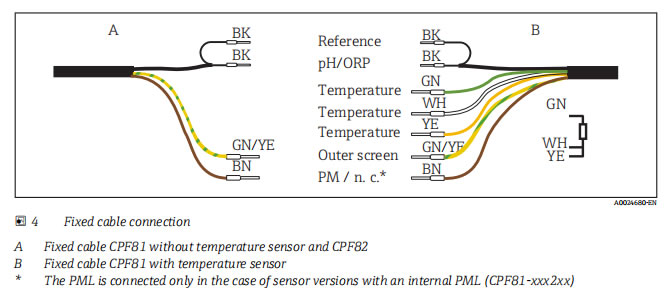News
Endress+Hauser pH/ORP sensor CPF81D-7LH21
|
Orbipac CPF81D/CPF82D and CPF81/CPF82
|
|||||||||||||||||||||||||||||||||||||||||||||||||||||||||||||||||||||||
|
pH/ORP sensors, with digital Memosens technology or analog
For mining operations, industrial water and wastewater treatment
|
|||||||||||||||||||||||||||||||||||||||||||||||||||||||||||||||||||||||
|
Application
• Flotation
• Leaching
• Neutralization
• Outlet monitoring
|
|||||||||||||||||||||||||||||||||||||||||||||||||||||||||||||||||||||||
|
Your benefits
• With patented KNO3 electrolyte bridge for improved protection against electrode
poisons such as S2- or CN- ions
• Optionally available with flat membrane for improved wear resistance
• Threaded connection NPT ¾" top and bottom for easy installation at user end
• Suitable for measurements in the 0 to 14 pH range and in the 0 to 110 °C
(32 to 230 °F) temperature range
• Digital pH sensors with integrated temperature sensor, analog pH sensors with or
without integrated temperature sensor
• Protection guard against damage
|
|||||||||||||||||||||||||||||||||||||||||||||||||||||||||||||||||||||||
|
Other advantages provided by Memosens technology
• Maximum process safety
• Data security thanks to digital data transmission
• Very easy to use as sensor data are saved in the sensor
• Predictive maintenance can be performed by recording sensor load data in the sensor
|
|||||||||||||||||||||||||||||||||||||||||||||||||||||||||||||||||||||||
|
Function and system design
|
|||||||||||||||||||||||||||||||||||||||||||||||||||||||||||||||||||||||
|
Measuring principle
|
pH measurement
The pH value is used as a unit of measurement for the acidity or alkalinity of a medium. The
membrane glass of the electrode delivers an electrochemical potential that depends on the pH value
of the medium. This potential is generated by the selective accumulation of H+ ions on the outer
layer of the membrane. As a result, an electrochemical boundary layer with an electrical potential
difference forms at this point. An integrated Ag/AgCl reference system serves as the required
reference electrode.
The measured voltage is converted to the corresponding pH value using the Nernst equation.
ORP measurement
The ORP potential is a unit of measurement for the state of equilibria between oxidizing and
reducing components of a medium. The ORP is measured using a platinum or gold electrode. Analog
to the pH measurement, an integrated Ag/AgCl reference system is used as a reference electrode.
|
||||||||||||||||||||||||||||||||||||||||||||||||||||||||||||||||||||||
|
Measuring system
|
A complete measuring system comprises:
• Sensor CPF81D, CPF81, CPF82D or CPF82
• Transmitter, e.g. Liquiline CM44x/R or Liquiline M CM42
• Measuring cable, e.g. CYK10 or sensor fixed cable
|
||||||||||||||||||||||||||||||||||||||||||||||||||||||||||||||||||||||
|
Endress+Hauser CPF81D-7LH21
|
|||||||||||||||||||||||||||||||||||||||||||||||||||||||||||||||||||||||
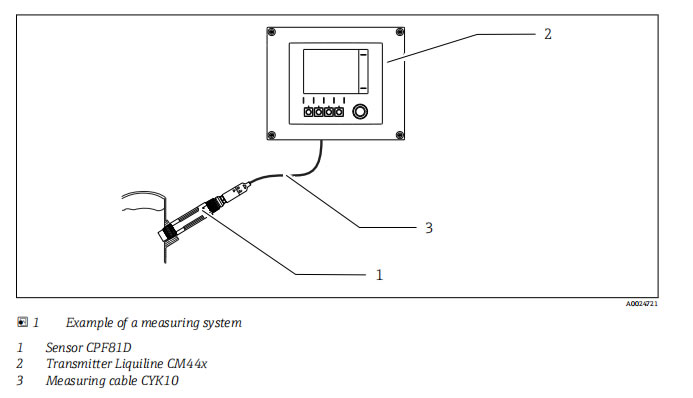
Communication and data transmission
Communication with the transmitter
Always connect digital sensors with Memosens technology to a transmitter with Memosens
technology. Data transmission to a transmitter for analog sensors is not possible.
Digital sensors can store measuring system data in the sensor. These include the following:
• Manufacturing data
• Serial number
• Order code
• Date of manufacture
• Calibration data
• Calibration date
• Calibrated slope at 25 °C (77 °F) (CPF81D)
• Calibrated zero point at 25 °C (77 °F) (CPF81D)
• Calibrated offset (CPF82D, ORP mV measuring mode)
• Slope as % (CPF82D, ORP % measuring mode)
• Temperature offset
• Number of calibrations
• Serial number of the transmitter used for the last calibration
• Calibration database (stores the last 8 calibrations in the Memosens head)
• Application data
• Temperature application range
• pH application range (CPF81D)
• ORP application range (CPF82D)
• Date of first commissioning
• Maximum temperature value
• Operating hours at temperatures above 80 °C (176 °F) and 100 °C (212 °F)
• Operating hours at very low and very high pH values (Nernst voltage below -300 mV, above
+300 mV)
Input
|
Measured values
|
CPF81D and CPF81
pH value
Temperature
CPF82D and CPF82
ORP
|
|
Measuring range
|
CPF81D and CPF81
Version LH
• pH: 0 to 14
• Temperature: 0 to 110 °C (32 to 230 °F)
Version NN
• pH: 0 to 14 (11 to 14 with reduced accuracy)
• Temperature: 0 to 80 °C (32 to 176 °F)
CPF82D, CPF82
-1500 mV to +1500 mV
|
|
Power supply
|
|
|
Electrical connection
|
CPF81D and CPF82D
The electrical connection to the transmitter is established using measuring cable CYK10.
|

|
|
|
CPF81 and CPF82 with TOP68 plug-in head
|
|
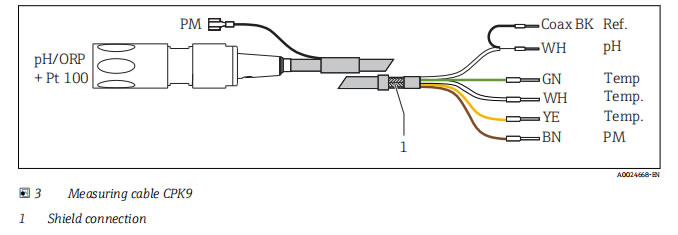
|
|
|
CPF81 and CPF82 with fixed cable
|
|
|
|
|
|
Installation |
|
|
Installation instructions
|
• Before screwing in the sensor, make sure the assembly thread, the O-rings and the sealing surface
are clean and undamaged and that the thread runs smoothly.
• Pay attention to the installation instructions provided in the Operating Instructions of the
assembly used.
‣ Screw in the sensor and tighten by hand with a torque of 3 Nm (2.21 lbf ft) (specifications only
apply if installing in Endress+Hauser assemblies).
|
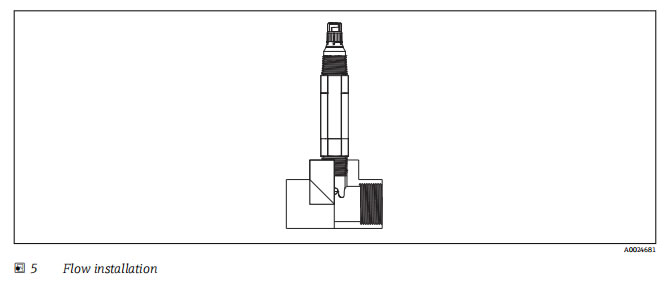
|
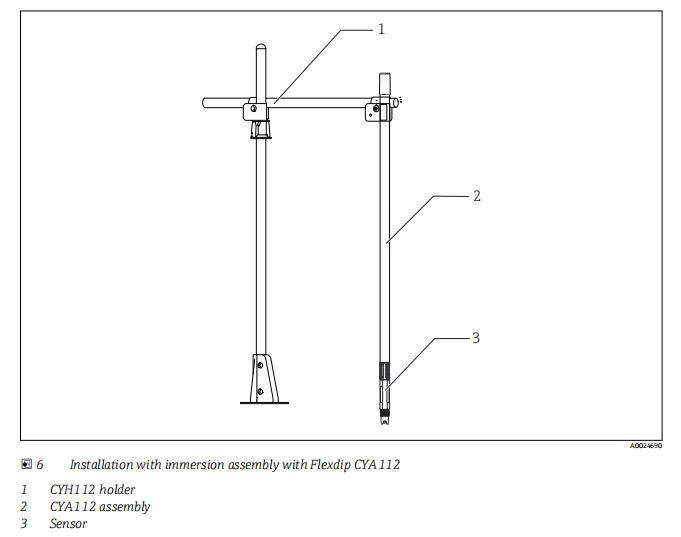
|
|
|
Mechanical construction |
|
|
Design, dimensions
|
ntegrated preamplifier (optional)
Structure cast in sensor body
Power supply via integrated coin cells
Reference potential: reference electrode
|
|
Dimensions
|
CPF81D, CPF82D
|
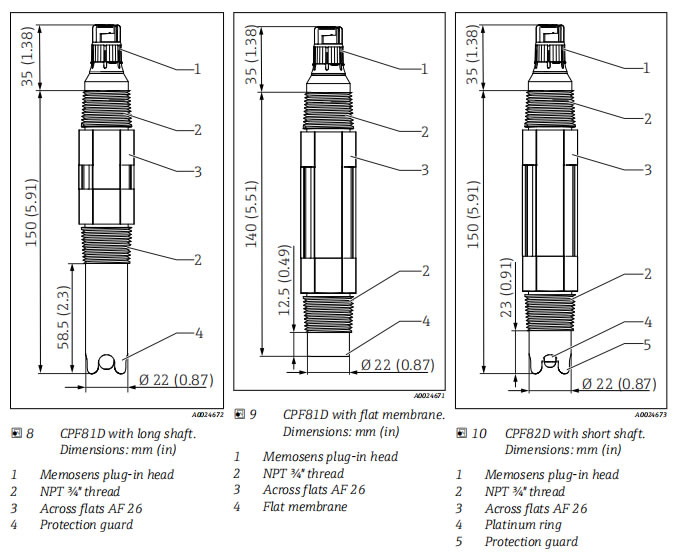
|
|
|
CPF81, CPF82
|
|
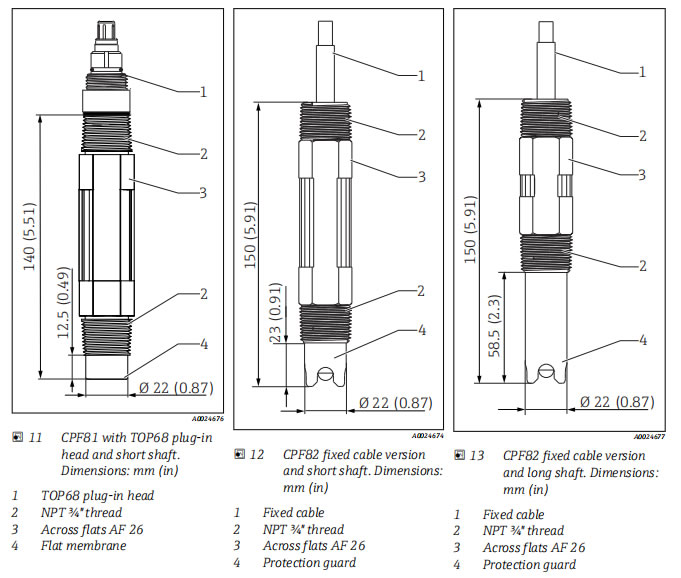
|
|
CATEGORIES
CONTACT US
Name: Sophie Wang
Mobile:+86 18681453433
Tel:+86 18681453433
Whatsapp:8613244706006
Email:sophie@meterbook.com
Add:Jingying Plot,Baoan District,Shenzhen City,Guangdong Province,China

